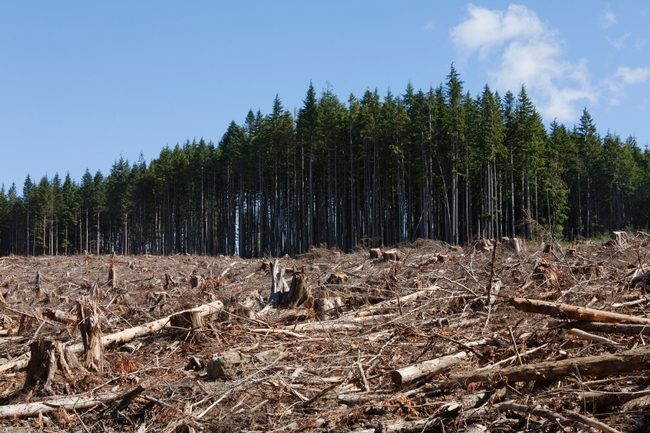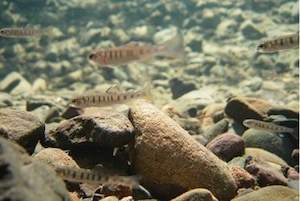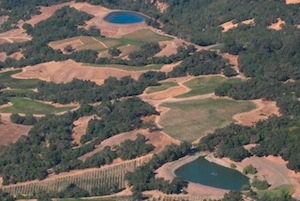UC Blogs
When, where and how wood is used impacts carbons emissions
How wood is used after it is cleared from a forest and where that forest is located largely affects the amount of greenhouse gas emissions released into the atmosphere, according to a new study by UC Davis.
The study, published this week in the advance online edition of the journal Nature Climate Change, provides a deeper understanding of the complex global impacts of deforestation on carbon storage and greenhouse gas emissions.
When trees are felled to create solid wood products, such as lumber for housing, that wood retains much of its carbon for decades, the researchers found. In contrast, when wood is used for bioenergy or turned into pulp for paper, nearly all of its carbon is released into the atmosphere. Carbon is a major contributor to greenhouse gases.
“We found that 30 years after a forest clearing, between 0 percent and 62 percent of carbon from that forest might remain in storage,” said lead author J. Mason Earles, a doctoral student with the UC Davis Institute of Transportation Studies. “Previous models generally assumed that it was all released immediately.”
The researchers analyzed how 169 countries use harvested forests. They learned that the temperate forests found in the United States, Canada and parts of Europe are cleared primarily for use in solid wood products, while the tropical forests of the Southern Hemisphere are more often cleared for use in energy and paper production.
“Carbon stored in forests outside Europe, the USA and Canada, for example, in tropical climates such as Brazil and Indonesia, will be almost entirely lost shortly after clearance,” the study states.
The study’s findings have potential implications for biofuel incentives based on greenhouse gas emissions. For instance, if the United States decides to incentivize corn-based ethanol, less profitable crops, such as soybeans, may shift to other countries. And those countries might clear more forests to make way for the new crops. Where those countries are located and how the wood from those forests is used would affect how much carbon would be released into the atmosphere.
Earles said the study provides new information that could help inform climate models of the Intergovernmental Panel on Climate Change, the leading international body for the assessment of climate change.
“This is just one of the pieces that fit into this land-use issue,” said Earles. Land use is a driving factor of climate change. “We hope it will give climate models some concrete data on emissions factors they can use.”
In addition to Earles, the study, “Timing of carbon emissions from global forest clearance,” was co-authored by Sonia Yeh, a research scientist with the UC Davis Institute of Transportation Studies, and Kenneth E. Skog of the U.S. Department of Agriculture Forest Service.
The study was funded by the California Air Resources Board and the David and Lucile Packard Foundation.
Wine and fish for dinner? Water management required
The competition between farmers and fish for precious water in California is intensifying in wine country, say biologists at the University of California, Berkeley.
The researchers found that juvenile steelhead trout are particularly at risk during the dry summer season typical of California’s Mediterranean climate. Of the juvenile steelhead trout present in June, on average only 30 percent survived to the late summer. In years with higher rainfall and in watersheds with less vineyard land use, the survival of juvenile trout over the summer was significantly higher.
The researchers pointed out that salmon and trout conservation efforts have not adequately addressed summer stream flow. Previous studies have highlighted other limiting factors such as habitat degradation and water quality, while this study documented the importance of water quantity for restoring threatened populations.
Grantham says he is not suggesting we get rid of vineyards. “But we do need to focus our attention on water management strategies that reduce summer water use. I believe we can protect flows for fish and still have our glass of wine.”
Fountain Time
Sometimes I sit in my garden and enjoy listening to the quiet. I spend the better part of my day listening to kids, and I wouldn't have it any other way, but every now and then I just love to hear the quiet. However, lately I have been sitting out there and thinking it would be really nice to have some sort of fountain. I've had a birdbath for a number of years, and I keep it full of fresh water because so many birds stop by it every day. They love to take a short "dip" in the water and then fly off. I figure that the little sounds of water I hear when they are bathing would be that much nicer to hear coming from the sound of a small fountain, right?
Most of us have heard that the sound of water can be very soothing and even help lower our stress level. It can actually help cool you down to hear the sound of water on a hot day, and with the intense heat we are prone to in the summer, that could be a very good thing. The area around the fountain, having a higher level of humidity, is great for the plants in the garden. Also, the addition of any water feature in a landscape is beneficial to the birds and insects we want in our gardens. It gives them a place to rehydrate and cool off.
I think I have convinced myself that it's time for a fountain!
A Pomegranate Kind of Day
It was a pomegranate kind of day. Red, bright and wonderful.The papery-thin reddish blossoms in our yard draw both beneficial and pestiferous...
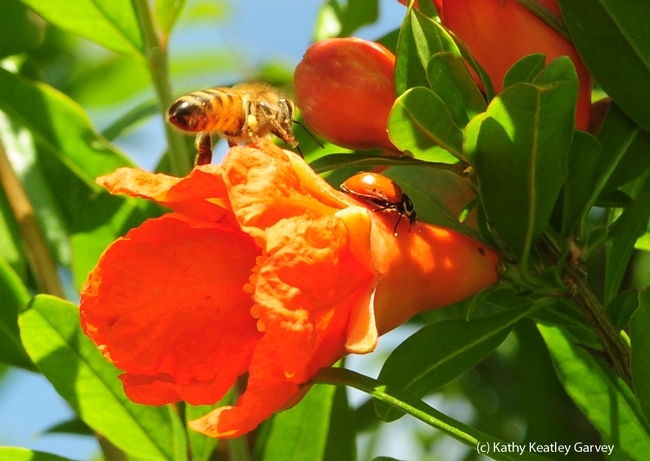
Honey bee nearly collides with a ladybug, aka ladybeetle. (Photo by Kathy Keatley Garvey)
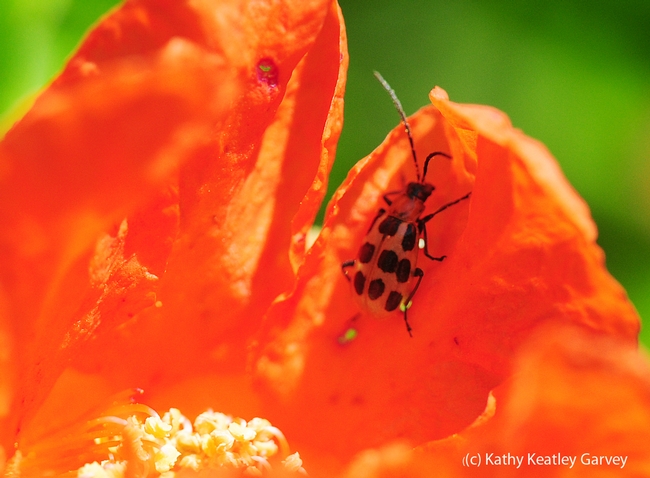
A pest, a spotted cucumber beetle. (Photo by Kathy Keatley Garvey)
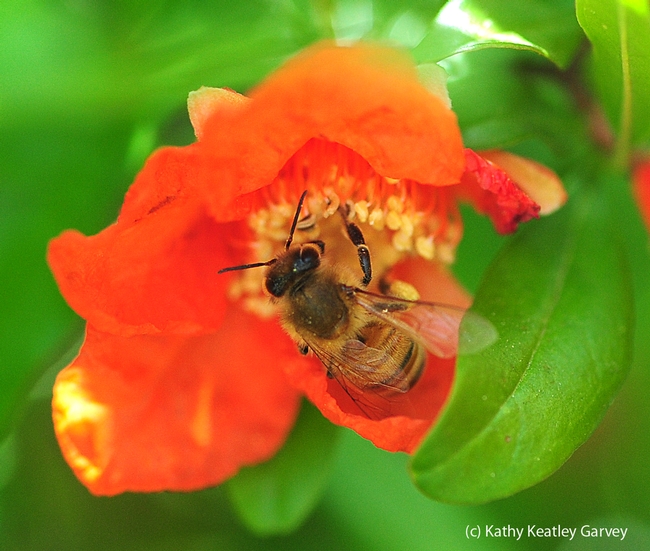
Honey bee foraging in pomegranate blossom. (Photo by Kathy Keatley Garvey)
Turfgrass Help
I am a turf gardener so I get a sense of satisfaction when my grass is full, dark green and lush on hot summer days. It takes proper year round care to make it through an entire Northern California summer unscathed by the changing conditions. The summer season introduces heat, wind, pests, and uneven watering patterns that turf gardeners in our region need to prepare for to ensure summer success. I want to provide a few tips on how to better prepare your turf for this season. It is important to mow turf regularly and to mow at the correct length for the conditions. It is critical to cut the lawn at a longer, higher length during the summer than you might the rest of the year. Turf that is cut at a longer length protects the roots from the midday heat and maintains moisture by slowing evaporation. Longer blades of grass also help prevent wind from drying out the topsoil. An important decision for turf a gardener is how often to water the grass when it is hot outside. Research shows that it is most effective to water deeply only a couple times a week rather than watering shallow and more frequently. An irrigation survey can be helpful in determining your ideal watering needs but a good rule of thumb if you don’t have time for a survey is to water at least twice a week until the soil is thoroughly saturated. In other words, a good deep drenching twice a week is better than 10 minutes every day. A quarterly fertilizer regiment should be implemented before the summer is in full swing to keep the roots well fed. Fertilizers should not be applied during warm summer days. Other treatments that you might consider are dethatching and aerating your turf to improve air flow to the roots and prevent disease. The most important tip to take from this blog is to raise the blade on your mower now through October to increase the length of the cut during the summer months. That tip alone should keep your turf healthier than it normally would if you were mowing at lower golf course levels. I attached a couple photos of grass being cut too short and not being watered deeply enough for reference.

Examples of unhealthy turf. (photos by Ed Walbolt)
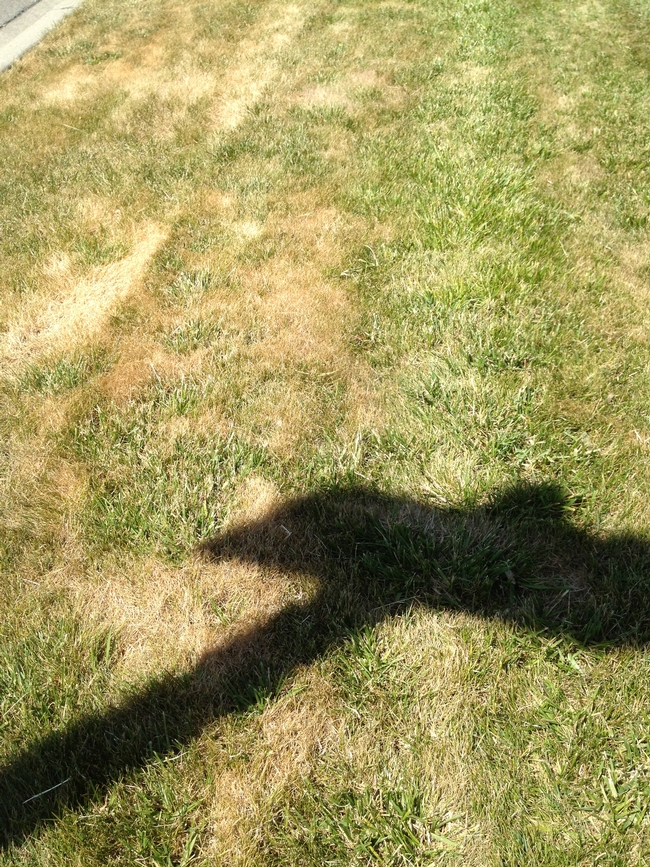
dry turff


